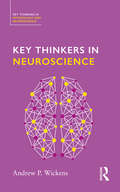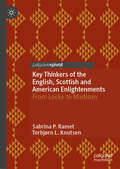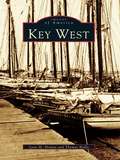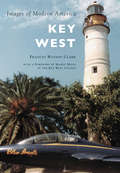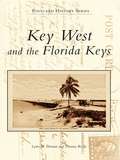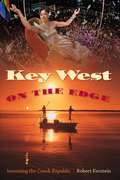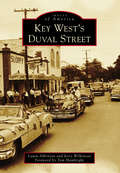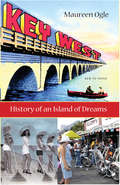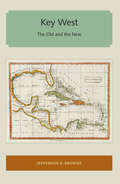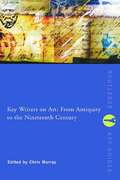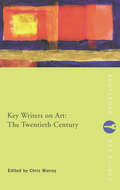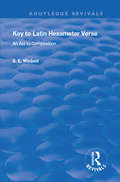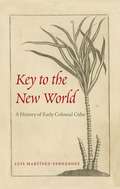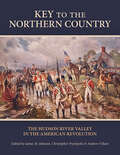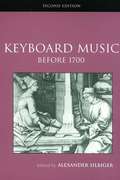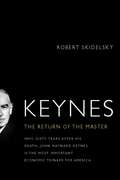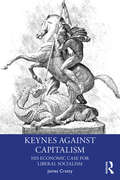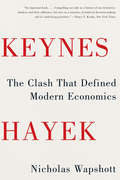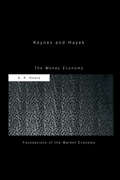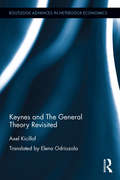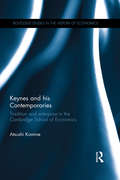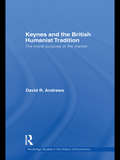- Table View
- List View
Key Thinkers in Neuroscience
by Andy WickensKey Thinkers in Neuroscience provides insight into the life and work of some of the most significant minds that have shaped the field. Studies of the human brain have been varied and complex, and the field is rich in pioneers whose endeavours have broken new ground in neuroscience. Adopting a chronological and multi-disciplinary approach to each Key Thinker, the book highlights their extraordinary contributions to neuroscience. Beginning with Santiago Ramon y Cajal and finishing with the philosophers Patricia Churchland and Paul Churchland, this book provides a comprehensive look at the new ideas and discoveries that have shaped neuroscientific research and practice, and the people that have been invaluable to this field. This book will be an indispensable companion for all students of neuroscience and the history of psychology, as well as anyone interested in how we have built our knowledge of the brain.
Key Thinkers of the English, Scottish and American Enlightenments: From Locke to Madison
by Sabrina P. Ramet Torbjørn L. KnutsenThis book summarizes and explains the way in which political thinkers in England, Scotland, and North America reshaped Western thinking about government and citizens. Although the ideas of the Anglo-American Enlightenment can be traced back, in embryo, to the Italian Renaissance and the Protestant Reformation, it was responses to wars – the Thirty Years’ War (1618-1648) and the English Civil War (1642-1651) which were fought above all over religion – that defined it. Algernon Sidney demanded an end to royal absolutism. John Locke called for a government based on religious toleration. Benedictus de Spinoza, Samuel von Pufendorf and others elaborated on the ideas that society was composed of sovereign individuals endowed with reason and rights. Building on the works of these thinkers, Scottish philosophers including David Hume and Adam Smith, and American revolutionaries including Thomas Jefferson and James Madison advanced arguments defending human reason, individual freedom, including religious freedom, and democracy.
Key To The Sinai: The Battles For Abu Agelia In The 1956 And 1967 Arab Israeli Wars [Illustrated Edition]
by George W. Gawrych[Includes 5 figures and 21 maps]Situated between the Suez Canal and Israel and marked by the harsh environment of the central Sinai lies Abu Ageila, an unprepossessing area of low ridges and hills through which passes the best-surfaced road in the peninsula. Owing to its location on the central route, close to the Israeli-Egyptian border, Abu Ageila became the key to the Sinai in the Arab-Israeli wars of 1956 and 1967. The struggle for this barren land in two wars provides an epic story of battle and reveals the influence of experience on the preparation for and conduct of war.In both the 1956 and 1967 wars, Abu Ageila was the main gateway to the Sinai for the Israel Defense Forces. Yet, as Dr. George W. Gawrych demonstrates, there were marked differences between Egyptian and Israeli war plans, preparations, operations, and results in the two battles for the area. In 1956, Israel carried the burden of a constricting alliance with Britain and France and faced other extensive military problems. The result was that Israel fought a difficult and costly battle for Abu Ageila. In contrast, in 1967, the Israel Defense Forces developed a brilliant operational plan and achieved effective unit command and control and attained a decisive victory.Based on extensive research, including personal interviews with Israeli commanders and briefings by Egyptian military historians, Key to the Sinai is a crisp battle narrative of desert warfare and a systematic historical analysis of two armies confronting the changing terms of battle. Students of AirLand Battle doctrine will find reading this Research Survey a stimulus to meeting the challenges of modern warfare.
Key Topics in Sociolinguistics: Language Maintenance and Shift
by Anne PauwelsWhat motivates some linguistic minorities to maintain their language? Why do others shift away from it rather quickly? Are there specific conditions - environmental or personal - influencing these dynamics? What can families and communities do to pass on their 'threatened' language to the next generation? These and related questions are investigated in detail in Language Maintenance and Shift. In this fascinating book, Anne Pauwels analyses the patterns of language use exhibited by individuals and groups living in multilingual societies, and explores their efforts to maintain their heritage or minority language. She explores the various methods used to analyse language maintenance, from linguistic demography to linguistic biography, and offers guidance on how to research the language patterns and practices of linguistic minorities around the world.
Key West (Images of America)
by Lynn M. Homan Thomas ReillyMuch more than the typical vacation destination, Key West combines a free-spirited ambiance with magnificent coral reefs, a unique historic legacy with an enduring artistic sensibility. For centuries, explorers and adventurers, immigrants and entrepreneurs, artists and wanderers have come to the island oasis, and today Key West, a city like no other, is home to them all. Through hurricanes, fires, labor strikes, and the tourism boom, the community of Key West has sustained a unique way of life and attracted a wide variety of people to its shores, including such famous figures as writers Ernest Hemingway and Tennessee Williams, President Harry Truman, and musician Jimmy Buffett. Whether strolling through the downtown historic district, searching eclectic shops for one-of-a-kind treasures, enjoying a piece of key lime pie, or participating in the look-alike contest during Hemingway Days, Key West offers endless opportunities for pleasure. The landmarks, the people, and the continuing story of Key West are the entertaining subject of this new photographic tribute.
Key West (Images of Modern America)
by Frances Watson Clark Mandy MilesKey West has a colorful history. It was the beachhead that protected the United States from the Soviet Union and Cuba in the 1960s, its literary and music scenes attracted and developed writers, artists, and musicians in the 1970s, and it seceded from the Union and created a new nation, the Conch Republic, in the 1980s. Through the rest of the decades to the present, festivals, celebrations, and revelries have drawn tourists here year-round and supported the Conchs, the key's residents. The vibrant community, people and places, military presence, and significant historic sites make Key West one of the most interesting places in the United States.
Key West and the Florida Keys (Postcard History)
by Lynn M. Homan Thomas ReillyA trip along that magical ribbon of road from the Florida mainland to the "Southernmost City" of Key West makes for an unforgettable journey. Dive the coral reefs at Key Largo's John Pennecamp State Park. Check out the dolphin show at Islamorada. Pack the fishing gear and head out to sea from Marathon. At Pigeon Key, relive the experiences of the workers who built Flagler's Folly, the Overseas Railroad. Climb a historic lighthouse in Key West. Stay at a fancy resort or a mom-andpop motel. Dine on fresh seafood or just-caught Florida lobster. Awaken to a glorious sunrise over the Atlantic Ocean and end the day with a spectacular sunset over the Gulf of Mexico.
Key West on the Edge: Inventing the Conch Republic (Florida History and Culture)
by Kerstein RobertKey West lies at the southernmost point of the continental Unites States, ninety miles from Cuba, at Mile Marker 0 on famed U.S. Highway 1. Famous for six-toed cats in the Hemingway House, Sloppy Joe’s and Captain Tony's, Jimmy Buffett songs, body paint parade "costumes," and a brief secession from the Union after which the Conch Republic asked for $1 billion in foreign aid, Key West also lies at the metaphorical edge of our sensibilities.How this unlikely city came to be a tourist mecca is the subject of Robert Kerstein's intrepid new history. Sited on an island only four miles long and two miles wide, Key West has been fishing village, salvage yard, U.S. Navy base, cigar factory, hippie haven, gay enclave, cruise ship port-of-call, and more. Duval Street, which stretches the length of one of the most unusual cities in America, is today lined with brand-name shops that can be found in any major shopping mall in America.Leaving no stone unturned, Kerstein reveals how Key West has changed dramatically over the years while holding on to the uniqueness that continues to attract tourists and new residents to the island.
Key West's Duval Street
by Jerry Wilkinson Laura Albritton Tom HambrightDuval Street, the pulsing heart of historic Key West, is one of the most legendary avenues in the United States. Stretching from the Atlantic Ocean to the Gulf of Mexico, this iconic thoroughfare has seen everyone from Ulysses S. Grant to Ernest Hemingway. Collecting remarkable archival photographs, Images of America: Key West�s Duval Street features famous buildings such as Key West�s Oldest House, St. Paul�s Church, the Southernmost House, the Strand Theater, the San Carlos Institute, and La Concha Hotel, along with fabled bars like Sloppy Joe�s and the Bull & Whistle. This book celebrates the irrepressible spirit and heritage of a much-beloved American destination.
Key West: History of an Island of Dreams
by Maureen Ogle"Ogle captures this island city in all its quirky charm. Her story breezes along in typical Key West fashion--full of gossip and humor, with the jolt of a good cup of Cuban coffee."--Lee Irby, University of South Florida, St. Petersburg Parrotheads, Hemingway aficionados, and sun worshipers view Key West as a tropical paradise, and scores of writers have set tales of mystery and romance on the island. The city's real story--told by Maureen Ogle in this lively and engaging illustrated account--is as fabulous as fiction. In the early 1800s, the city's pioneer founders battled Indians, pirates, and deadly disease and created wealth beyond their imaginations. In the two centuries since, Key West has nurtured tragedy and triumph and has stood at the crossroads of American history. When Florida joined the Confederacy in 1861, Union troops seized control of strategically located Key West and city residents spent four years living under martial law. In the early 1890s, Key West Cubans helped Jose Marti launch the revolution that eventually ended Spain's control of their homeland. A few years later, the battleship Maine steamed out of Key West harbor on its last, tragic voyage. At the turn of the century, Henry Flagler astounded the entire country by building a technological marvel, an overseas railroad from mainland Florida to Key West, more than 100 miles long. In the 1920s and 1930s, painters, rumrunners, and writers (including Ernest Hemingway and Robert Frost) discovered Key West. During World War II, the federal government and the military war machine permanently altered the island's landscape. In the second half of the 20th century, bohemians, hippies, gays, and jet-setters began writing a new chapter in Key West's social history. All of these personalities and events are wrapped in Ogle's unique and candid history of the island, an account that will fascinate past and present citizens of the Conch Republic, history buffs who like a well-told tale, and the millions of tourists from all over the world who love this colorful island city. Maureen Ogle is retired from the University of South Alabama.
Key West: The Old and the New (Florida and the Caribbean Open Books Series)
by Jefferson B. BrowneThe books in the Florida and the Caribbean Open Books Series demonstrate the University Press of Florida’s long history of publishing Latin American and Caribbean studies titles that connect in and through Florida, highlighting the connections between the Sunshine State and its neighboring islands. Books in this series show how early explorers found and settled Florida and the Caribbean. They tell the tales of early pioneers, both foreign and domestic. They examine topics critical to the area such as travel, migration, economic opportunity, and tourism. They look at the growth of Florida and the Caribbean and the attendant pressures on the environment, culture, urban development, and the movement of peoples, both forced and voluntary.The Florida and the Caribbean Open Books Series gathers the rich data available in these architectural, archaeological, cultural, and historical works, as well as the travelogues and naturalists’ sketches of the area prior to the twentieth century, making it accessible for scholars and the general public alike.The Florida and the Caribbean Open Books Series is made possible through a grant from the National Endowment for the Humanities and the Andrew W. Mellon Foundation, under the Humanities Open Books program.
Key Writers on Art: From Antiquity to the Nineteenth Century (Routledge Key Guides)
by Chris MurrayKey Writers on Art: From Antiquity to the Nineteenth Century offers a unique and authoritative guide to theories of art from Ancient Greece to the end of the Victorian era, written by an international panel of expert contributors. Arranged chronologically to provide an historical framework, the 43 entries analyze the ideas of key philosophers, historians, art historians, art critics, artists and social scientists, including Plato, Aquinas, Alberti, Michelangelo, de Piles, Burke, Schiller, Winckelmann, Kant, Hegel, Burckhardt, Marx, Tolstoy, Taine, Baudelaire, Nietzsche, Ruskin, Pater, Wölfflin and Riegl.Each entry includes:* a critical essay* a short biography* a bibliography listing both primary and secondary textsUnique in its range and accessibly written, this book, together with its companion volume Key Writers on Art: The Twentieth Century, provides an invaluable guide for students as well as general readers with an interest in art history, aesthetics and visual culture.
Key Writers on Art: The Twentieth Century (Routledge Key Guides)
by Chris MurrayKey Writers on Art: The Twentieth Century offers a unique and authoritative guide to modern responses to art. Featuring 48 essays on the most important twentieth century writers and thinkers and written by an international panel of expert contributors, it introduces readers to key approaches and analytical tools used in the study of contemporary art. It discusses writers such as Adorno, Barthes, Benjamin, Freud, Greenberg, Heuser, Kristeva, Merleau-Ponty, Pollock, Read and Sontag.
Key to Latin Hexameter Verse: An Aid to Composition (Routledge Revivals)
by S. E. WinboltOriginally published in 1903.
Key to the New World: A History of Early Colonial Cuba
by Luis Martínez-FernándezFlorida Book Awards, Bronze Medal for General Nonfiction Scholarly and popular attention tends to focus heavily on Cuba’s recent history. Key to the New World is the first comprehensive history of early colonial Cuba written in English, and fills the gap in our knowledge of the island before 1700.
Key to the Northern Country: The Hudson River Valley in the American Revolution (SUNY series, An American Region: Studies in the Hudson Valley)
by James M. Johnson Christopher Pryslopski Andrew VillaniThe Hudson River Valley, which George Washington referred to as the "Key to the Northern Country," played a central role in the American Revolution. From 1776 to 1780, with major battles fought at Saratoga, Fort Montgomery, and Stony Point, the region was a central battleground of the Revolution. In addition, it witnessed some of the most dramatic and memorable aspects of the war, such as Benedict Arnold's failed conspiracy at West Point, the burning of New York's capital at Kingston, and the more than six-hundred-mile march of Washington and the Continental Army and Jean Baptiste Donatien de Vimeur, comte de Rochambeau, and his French Expeditionary Corps to Yorktown, Virginia. Compiled from essays that appeared in the Hudson Valley Regional Review and the Hudson River Valley Review, published by the Hudson River Valley Institute, the book illustrates the richly textured history of this supremely important time and place.
Keyboard Music Before 1700 (Studies In Musical Genres And Repertories)
by Alexander SilbigerKeyboard Music Before 1700 begins with an overview of the development of keyboard music in Europe. Then, individual chapters by noted authorities in the field cover the key composers and repertory before 1700 in England, France, Germany and the Netherlands, Italy, and Spain and Portugal. The book concludes with a chapter on performance practice, which addresses current issues in the interpretation and revival of this music.
Keynes
by Robert SkidelskyThe ideas of John Maynard Keynes have never been more timely. No one has bettered Keynes's description of the psychology of investors during a financial crisis: 'The practice of calmness and immobility, of certainty and security, suddenly breaks down. New fears and hopes will, without warning, take charge of human conduct... the market will be subject to waves of optimistic and pessimistic sentiment.' Keynes's preeminent biographer, Robert Skidelsky, Emeritus Professor of Political Economy at the University of Warwick, brilliantly synthesizes from Keynes's career and life the aspects of his thinking that apply most directly to the world we currently live in. In so doing, Skidelsky shows that Keynes's mixture of pragmatism and realism - which distinguished his thinking from the neo-classical or Chicago school of economics that has been the dominant influence since the Thatcher-Reagan era and which made possible the raw market capitalism that created the current global financial crisis - is more pertinent and applicable than ever. Crucially Keynes offers nervous capitalists - and Keynes never wavered in his belief in the capitalist system - a positive answer to the question we now face: When unbridled capitalism falters, is there an alternative? "In the long run," as Keynes famously said, "we are all dead". We may not have time to wait for the perfect theoretical operation of capital as the neo-classicists insist will happen eventually. In the meantime, we have Keynes: more supple, more human and more magnificently real than ever.
Keynes Against Capitalism: His Economic Case for Liberal Socialism (Economics as Social Theory)
by James CrottyKeynes is one of the most important and influential economists who ever lived. It is almost universally believed that Keynes wrote his magnum opus, The General Theory of Employment, Interest and Money, to save capitalism from the socialist, communist, and fascist forces that were rising up during the Great Depression era. This book argues that this was not the case with respect to socialism. Tracing the evolution of Keynes’s views on policy from WWI until his death in 1946, Crotty argues that virtually all post-WWII "Keynesian" economists misinterpreted crucial parts of Keynes’s economic theory, misunderstood many of his policy views, and failed to realize that his overarching political objective was not to save British capitalism, but rather to replace it with Liberal Socialism. This book shows how Keynes’s Liberal Socialism began to take shape in his mind in the mid-1920s, evolved into a more concrete institutional form over the next decade or so, and was laid out in detail in his work on postwar economic planning at Britain’s Treasury during WWII. Finally, it explains how The General Theory provided the rigorous economic theoretical foundation needed to support his case against capitalism in support of Liberal Socialism. Offering an original and highly informative exposition of Keynes’s work, this book should be of great interest to teachers and students of economics. It should also appeal to a general audience interested in the role the most important economist of the 20th century played in developing the case against capitalism and in support of Liberal Socialism. Keynes Against Capitalism is especially relevant in the context of today’s global economic and political crises.
Keynes Hayek: The Clash that Defined Modern Economics
by Nicholas Wapshott"I defy anybody--Keynesian, Hayekian, or uncommitted--to read [Wapshott's] work and not learn something new."--John Cassidy, The New Yorker As the stock market crash of 1929 plunged the world into turmoil, two men emerged with competing claims on how to restore balance to economies gone awry. John Maynard Keynes, the mercurial Cambridge economist, believed that government had a duty to spend when others would not. He met his opposite in a little-known Austrian economics professor, Freidrich Hayek, who considered attempts to intervene both pointless and potentially dangerous. The battle lines thus drawn, Keynesian economics would dominate for decades and coincide with an era of unprecedented prosperity, but conservative economists and political leaders would eventually embrace and execute Hayek's contrary vision. From their first face-to-face encounter to the heated arguments between their ardent disciples, Nicholas Wapshott here unearths the contemporary relevance of Keynes and Hayek, as present-day arguments over the virtues of the free market and government intervention rage with the same ferocity as they did in the 1930s.
Keynes and Friedman on Laissez-Faire and Planning: ‘Where to draw the line?’ (Routledge Studies in the History of Economics)
by Sylvie RivotThe 2008 crisis has revived debates on the relevance of laissez-faire, and thus on the role of the State in a modern economy. This volume offers a new exploration of the writings of Keynes and Friedman on this topic, highlighting not only the clear points of opposition between them, but also the places in which their concerns where shared. This volume argues that the parallel currently made with the 1929 financial crisis and the way the latter turned into the Great Depression sheds new light on the proper economic policy to be conducted in both the short- and the long-run in a monetary economy. In light of the recent revival in appreciation for Keynes’ ideas, Rivot investigates what both Keynes and Friedman had to say on key issues, including their respective interpretations of both the 1929 crisis and the Great Depression, their advocacy of the proper employment policy, and the theoretical underpinnings of the latter. The book asks which lessons should be learnt from the Thirties? And what is the relevance of Keynes’ and Friedman’s respective pleas for today?
Keynes and Hayek: The Money Economy (Routledge Foundations of the Market Economy)
by G R SteeleJohn Maynard Keynes and Friedrich Hayek had serious differences of opinion when it came to assessing the fractured inter-war world. G. R. Steele picks apart this debate and argues persuasively that Hayek's outlook will prove to be the more enduring.
Keynes and The General Theory Revisited (Routledge Advances in Heterodox Economics #36)
by Axel KicillofEvery time the economy goes through a period of crisis, Keynes’ name is called upon by economists and politicians from diverse backgrounds. However, 70 years after the publication of The General Theory of Employment, Interest and Money, specialists are still far—maybe everyday further—from reaching agreement about the genuine contents of Keynes’ most important work. This controversy has been marked by a paradoxical turn: it is above all the literature about Keynes which, in the last decades, has imposed the terms of the debate, while The General Theory lacks readers. Accused by both its detractors and admirers of being a confusing book that is inconsistent and even plagued with logical errors, the most important contribution of the most influential economist of the 20th century has been condemned to be forgotten or, at best, to live uncomfortably in the voices of those who have spoken on his behalf. This book is the result of rigorous critical research which reconstructs the spectrum of discussion surrounding Keynes’ main work. The book begins by describing the historical background and the state of the pre-Keynesian economic theory, subsequently immersing the reader in a concise but detailed—as well as innovative— interpretation of the original text. The revision of some of the main interpretative currents prepares the field for the book’s ultimate contribution: the identification of the fundamentals that sustain the analytical structure of The General Theory. At the same time, this exploration of the theoretical fundamentals of The General Theory makes this book an original intervention on the genesis and relevance of the divide between micro and macroeconomics—a division that has been fully accepted by contemporary macro theorists.
Keynes and his Contemporaries: Tradition and Enterprise in the Cambridge School of Economics (Routledge Studies in the History of Economics)
by Atsushi KomineThis book examines how the Cambridge School economists, such as J. M. Keynes, constructed revolutionary theories and advocated drastic policies based on their ideals for social organizations and their personal characteristics. Although vast numbers of studies on Marshall, Keynes and Marshallians have been published, there have been very few studies on the ‘Keynesian Revolution’ or Keynes’s relevance to the modern world from archival and intellectual viewpoints which focus on Keynes as a member of the Cambridge School. This book approaches Keynes from three directions: person, time and perspective. The book provides a better understanding of how Keynes struggled with problems of his time and it also offers valuable lessons on how to survive fluctuating global capitalism today. It focuses on eight key economists as a group in ‘a public sphere’ rather than as a school (a unified theoretical denominator), and clarifies their visions and the widespread beliefs at the time by investigating their common motivations, lifestyles, values and habits.
Keynes and the British Humanist Tradition: The Moral Purpose of the Market
by David AndrewsWell-connected in academia, business and government, John Maynard Keynes was one of the most influential economic theorists of the twentieth century. It appears that his theories will be just as important for the twenty-first. As Keynes himself explained, his ideas throughout his life were influenced by the moral philosophy he learned as an undergraduate. Nevertheless, the meaning and significance for Keynes of this early philosophy have remained largely unexplored. Keynes and the British Humanist Tradition offers an interpretation of Keynes’s early philosophy and its implications for his later thought. It approaches that philosophy from the perspective of the nineteenth century intellectual context out of which it emerged. The book argues that roots of Keynes’s early beliefs are to be found in the traditions of the Apostles, the very famous secret society to which he and most of his teachers belonged. The principles of Keynes’s philosophy can be seen in such writers as John Stuart Mill and Henry Sidgwick, but the underlying ideas have been obscured by changing fashions in philosophy and thus require excavation and reconstruction. This book will be of interest to students and researchers in the history of economics, in particular the thought of John Maynard Keynes, especially his ethics, politics and economics.
